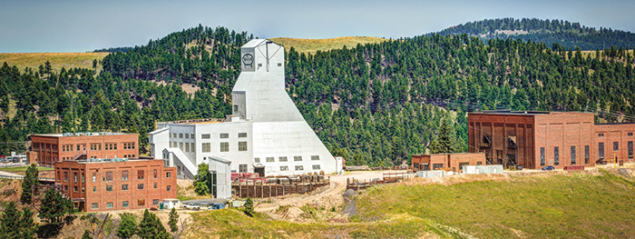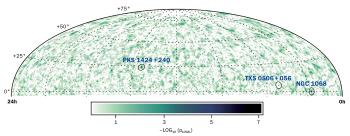The next-generation long-baseline neutrino-oscillation experiment is gaining global interest.

Image credit: Sanford Underground Research Facility.
The Deep Underground Neutrino Experiment (DUNE) is a next-generation long-baseline neutrino-oscillation experiment, currently under review by the US Department of Energy (DOE). DUNE has a potentially game-changing scientific programme for neutrino physics.
The DUNE collaboration came together in response to the US P5 report on the “Strategic Plan for US Particle Physics in the Global Context”, published in 2014, and the recommendations of the European Strategy for Particle Physics to freeze the development of neutrino beams at CERN. The P5 report called for the previously US-dominated LBNE experiment to be reformulated as a truly international scientific endeavour, incorporating the scientific goals and expertise of the worldwide neutrino-physics community, in particular those developed by LBNO in Europe. As a result, the international DUNE collaboration was formed and structured following a model that was successfully adopted by the LHC experiments.
The DUNE collaboration currently consists of almost 800 scientists and engineers from 145 institutes in 26 nations. The rapid development of this large collaboration is indicative of the global interest in neutrino physics and the innovative science made possible with the DUNE near and far detectors and the proposed Long-Baseline Neutrino Facility (LBNF) at Fermilab. The strong partnership between the US DOE and CERN already established in the LHC programme is also one of the essential components for the success of DUNE/LBNF. Construction of the CERN facility that will host two large-scale DUNE prototype detectors and a test beam has already begun.
So what is DUNE/LBNF? LBNF is a new 60–120 GeV beamline at Fermilab that can produce either an intense beam of muon neutrinos or antineutrinos. The initial beam power will be 1.2 MW (compared with the maximum planned for Fermilab’s existing NuMI beam of 700 kW for the NOvA experiment). This is just the first step for LBNF and the beam is being designed to be upgradable to at least 2.4 MW.
The neutrino beam will be directed towards a near and a far detector. DUNE’s far detector will be located 1.5 km underground at the Sanford Underground Research Facility (SURF) in South Dakota. Neutrinos will travel a distance of 1300 km through the Earth’s crust, therefore allowing the neutrino flavours to oscillate. The DUNE far detector consists of four 10 kton (fiducial) liquid-argon time projection chambers (LAr-TPCs). These detectors are very large – each will be approximately 62 × 15 × 14 m. The advantage of the LAr-TPC technology is that it allows 3D bubble-chamber-like imaging of neutrino interactions (or proton decay) in the vast detector volume. The DUNE near detector on the Fermilab site will observe the unoscillated neutrino beam, providing constraints on experimental uncertainties. By the standards of neutrino physics, the near-detector event rates are incredible – it will detect hundreds of millions of neutrino interactions. This will enable a diverse and world-leading neutrino-physics programme.

Image credit: DUNE Collaboration.
DUNE/LBNF has a broad and comprehensive scientific programme – it aims to make groundbreaking discoveries such as CP violation in the neutrino sector and measuring the corresponding CP phase. Because of the long baseline, DUNE will also conclusively determine the neutrino-mass ordering (normal versus inverted hierarchy). The sensitivity to the mass hierarchy arises because the neutrinos traverse 1300 km of matter (as opposed to antimatter). These “matter effects” imply that the oscillations of muon neutrinos to electron neutrinos are expected to differ from those of the corresponding process for antineutrinos, independent of CP violation. DUNE will measure both CP violation and the mass hierarchy in a single experiment by utilising a wide-band beam so that the oscillations can be measured as a function of neutrino energy (covering both first- and second-oscillation maxima). One of the advantages of a LAr-TPC is that it acts as a totally active calorimeter where the energy deposits from all final-state particles are detectable, resulting in an excellent neutrino-energy measurement over the broad range of energies needed to study the first- and second-oscillation maxima. In general, the large event samples of muon neutrino/antineutrino interactions (in the disappearance channel) and electron neutrino/antineutrino interactions (in the appearance channel) will enable neutrino oscillations to be probed with unprecedented precision, providing a test of the current three-flavour neutrino paradigm – there may yet be surprises lurking in the neutrino sector.
DUNE is not only about neutrinos. The large far detector with bubble-chamber-like imaging capability, located deep underground, provides an opportunity to search for proton decay. In particular, DUNE is able to search for proton-decay modes with kaons (such as the p → K+ antineutrino), which are favoured in many SUSY scenarios. The clear topological and ionisation (dE/dx) signature of these decay modes allows for a near-background-free search – a significant advantage in capability over large water Cherenkov detectors. Furthermore, DUNE will provide unique capabilities for the observation of neutrinos from core-collapse supernova bursts (SNBs). While water Cherenkov detectors are primarily sensitive to electron antineutrinos from SNBs, DUNE is mostly sensitive to the electron neutrinos. This would enable DUNE to directly observe the neutron-star-formation stage (p + e– → n + νe) in “real time”, albeit delayed by the time that it takes for neutrinos to reach the Earth – this would be a truly remarkable observation. There is even the possibility to observe the formation of a black hole as a sharp cut-off in the time spectrum of the SNB neutrinos, if the black hole were to form a few seconds after the stellar-core collapse.
CERN’s role
CERN is playing a crucial role in prototyping the DUNE far detector and in the detailed understanding of its performance. Following the recommendations of the European Strategy document, CERN has set up a programme to fulfil the needs of large-scale neutrino-detector prototyping. In the framework of this programme, a new neutrino “platform” is being brought to light in the North Area. The new CERN facility will be available for experiments in the autumn of 2016 and will include a 70 m extension of the EHN1 experimental hall, which will host the large experimental apparatus and expose them to charged-particle test beams. The plan is to operate the first charged-particle beams in 2017 after the civil engineering and infrastructure work needed to upgrade the experimental hall has been completed.

Image credit: CERN.
To deliver the DUNE far detector requires the LAr-TPC technology to be scaled up to an industrial scale. The CERN platform will support the development of the single-phase and dual-phase liquid-argon technologies that are being considered on a large scale for the DUNE far detectors. In the single-phase approach, the ionisation electrons produced by charged particles are drifted towards read-out wire planes in the liquid-argon volume. In the dual-phase approach, the ionisation electrons are amplified in gaseous argon above the liquid surface and then read out. The CERN platform will host two large-scale prototypes for the DUNE far detector – ProtoDUNE and WA105.
ProtoDUNE is the engineering prototype for the single-phase far-detector design currently planned for the first 10 kton far-detector module. ProtoDUNE is based on the pioneering work carried out for the ICARUS detector operated at the Gran Sasso underground laboratory. The ICARUS detector, with its 600 tonnes of liquid argon, took data from 2010 to 2012. It demonstrated that a liquid-argon TPC detector can provide detailed images of charged particles and electromagnetic showers, with excellent spatial and calorimetric resolution. ICARUS also demonstrated the long-term stability of the LAr-TPC concept.
The WA105 demonstrator will be based on the novel dual-phase liquid-argon time projection chamber that was developed by the European LAGUNA-LBNO consortium, with R&D efforts located at CERN for more than a decade. The dual-phase approach, which offers potential advantages over the single-phase read-out, is being considered by DUNE for one or more of the DUNE far-detector 10 kton modules. The WA105 collaboration is currently building a smaller-scale 25 tonne prototype at CERN, to be operated in 2016. The larger 300 tonne WA105 demonstrator should be ready for test beam by 2018 in the EHN1 extension of the North Area at CERN.
The goal of these prototypes is to validate the construction techniques that will be adopted for the deep-underground installation at SURF, and to measure the performance of full-scale modules. In addition, the EHN1 test beams will provide the unique capability to collect and analyse charged-particle data necessary to understand the response of these detectors, with the high precision required for the DUNE science programme. The CERN neutrino platform will also serve additional R&D efforts, in particular for the DUNE near detector, where the current design utilises a straw-tube tracking chamber (inspired by the earlier NOMAD experiment at CERN), but other options, such as a high-pressure gaseous-argon TPC, are being studied.
The DUNE/LBNF scientific programme has broad support from partners in the Americas, Asia and Europe, and the collaboration is expected to grow. Progress in the last year has been rapid; DUNE/LBNF produced a four-volume Conceptual Design Report (CDR) in July 2015, detailing the design of the DUNE near and far detectors and the design of LBNF, which encompasses both the new neutrino beamline at Fermilab and civil facilities for the DUNE detectors. The CDR was a crucial element of the DOE CD-1 review of the cost range for the project. DUNE/LBNF is currently seeking DOE CD-3a approval for the underground excavation of the far-site facility that would host the four far-detector modules. The timescales are relatively short, with the start of the excavation project planned for 2017 and installation of the first far-detector module planned to start in 2021, with first commissioning for physics starting soon after. The strong role of CERN in this programme is crucial to its success.
• For further details, see lbnf.fnal.gov and www.dunescience.org.








